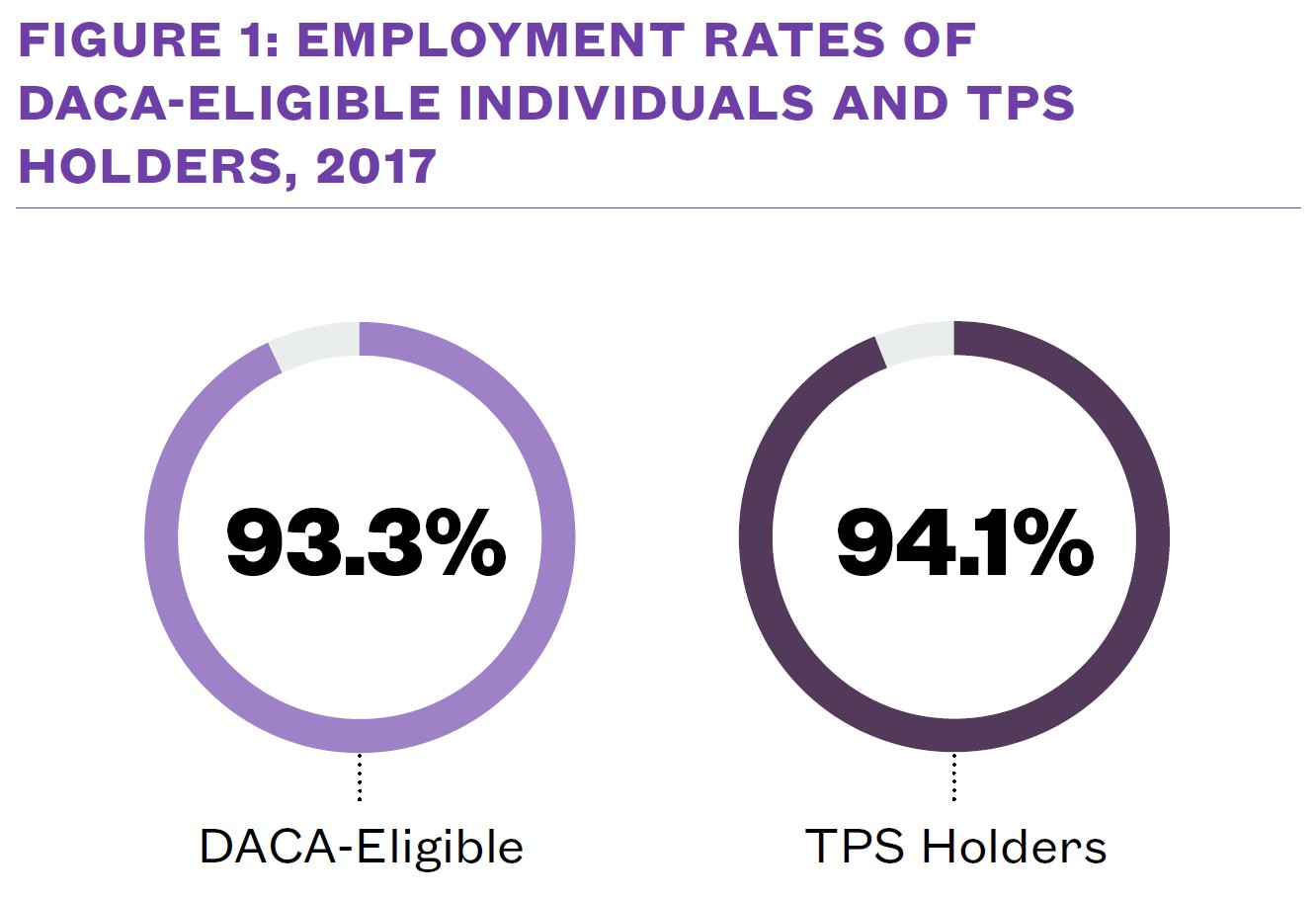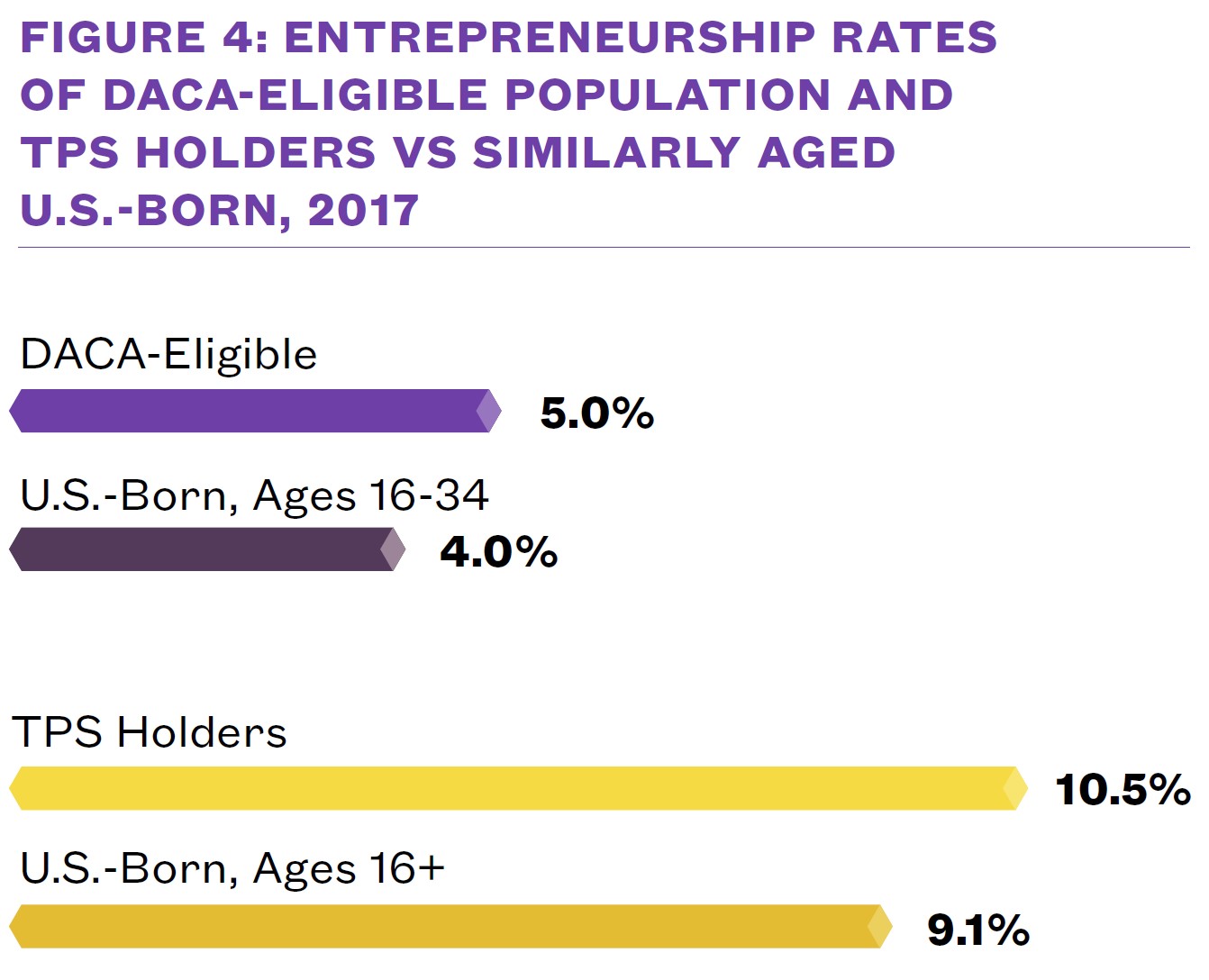Overcoming the Odds: The Contributions of DACA-Eligible Immigrants and TPS Holders to the U.S. Economy
Date: June 3, 2019

In many ways, Saba Nafees is a textbook example of the type of worker businesses in Texas report they need. As the Texas House Select Committee on Economic Competiveness was warning that the number of graduates with technical skills was not growing nearly fast enough to meet employer demand, Nafees graduated from Texas Tech University with a bachelor’s degree in mathematics with the highest honors.[1] She is now working towards a PhD in mathematical biology at the same school. On top of that, she’s already an entrepreneur. In 2017, Nafees and several classmates founded Pata, a startup that gives American consumers a platform to buy handmade rugs and handicrafts from Tibetan refugees abroad.
But one problem stands in the way of Nafees building her business or contributing her talents to a firm here in the United States. Nafees, whose parents brought her to the United States from Pakistan at age 11, is a recipient of the Deferred Action for Childhood Arrivals (DACA) program which gives undocumented immigrants brought to America as children a reprieve from deportation and authorization to work legally in the United States. While hundreds of thousands of young people have benefitted from DACA since its creation in 2012, in September 2017, the Trump administration attempted to end the program. Now, it is only because of favorable court rulings that current DACA holders have been able to hold on to their status. The government has stopped accepting new applications for DACA altogether—a large blow to the thousands of undocumented immigrants who are only now turning 15 and becoming eligible for the program and others who didn’t previously apply for DACA when they were able.[2]
The uncertainty of DACA’s future puts people like Nafees in a precarious situation. “I’ll always be grateful to the state of Texas for enabling me to develop my skills, and I’m happy for the chance to repay that investment,” says Nafees, who was able to take advantage of in-state college tuition thanks to Texas’s tuition equity law. But these days, while she’s taking classes and working to expand her business, she has to live with the fear that she could someday lose her work authorization—and worse—face deportation.
There’s a strong argument that losing someone like Nafees does not make much economic sense—particularly given her science and math skills, which are in critically short supply for U.S. employers.[3] The reality though is that these arguments sometimes get lost in the heat and emotion of the immigration debate.
In this report, we detail the economic contributions of the 1.3 million DACA-eligible people in the United States, as well as the more than 318,000 immigrants with Temporary Protected Status (TPS), a designation that allows individuals from countries facing severe temporary conditions—such as natural disasters, epidemics, or armed conflict—to live and work in the United States while their country remains in crisis. Like DACA, TPS has been similarly imperiled in recent months, with the Trump administration announcing it would terminate or allow protections to lapse for the 200,000 El Salvadorans, 50,000 Haitians, and thousands of Sudanese and Nicaraguans currently counting on TPS for protection. These TPS holders remain in the United States today only because of a court injunction, which extended protections through January 2020.[4]
Ending such programs, of course, would exact a heavy psychological toll on TPS and DACA holders. Dreamers, as undocumented immigrants who were brought to America as young children are known, could be deported to countries they don’t remember, where the language spoken is one that they don’t know. Meanwhile, TPS holders, many of whom have lived in the United States a decade or more, could be forced to return to places like El Salvador or Nicaragua where violence is ongoing.
For many, those realities would be reason enough to restore and preserve the DACA and TPS programs. In this brief, however, we focus on another: That the deportation of both TPS and DACA holders would represent a blow not only to the immigrants themselves and the millions of Americans who are their family members, friends, employees, and co-workers, but to the U.S. economy more broadly. In 2017 alone, TPS holders and the DACA-eligible together contributed more than $5.5 billion in taxes, including almost $2.5 billion to state and local governments. They also held $25.2 billion in spending power—money that, when spent on items like groceries, haircuts, or rent, supports countless U.S. businesses.
National Economic Impact
Since the creation of DACA in 2012, more than 700,000 people have taken advantage of the program.[5] While sizable, that number does not represent the full universe of people who are eligible to apply for DACA protections. Studies have found that some Dreamers failed to apply for the program because they were either unable to pay the $495 application fee or were worried about sharing private information with federal authorities.[6] In some communities, take-up was particularly low: The Migration Policy Institute estimates that just 3 percent of Chinese nationals who were eligible held DACA status in 2018, as did just 1 percent of Vietnamese and 13 percent of those from India.[7]
Because policies affecting Dreamers impact all those who are eligible for the program, in this report we cast a wider lens, looking at the 1.3 million people who were eligible for the DACA program as of 2017 the latest year for which data is available. We also focus on a group that has been similarly under threat of losing status in recent years: The more than 318,000 people in the country with TPS. This group includes nationals from places as diverse as El Salvador, Nepal, and Somalia. (More details on the population we study can be found in the Methodology Appendix.)
Employment and Earnings
The DACA-eligible population is by definition young. When the program was created in 2012, it was available only to immigrants ages 31 or below who were brought to the country as children. These immigrants could apply for reprieve from deportation and legal work authorization if they met certain criteria, including holding a high school degree or serving in the military. Because of these requirements, past NAE work has found that more than one out of every six DACA-eligible individuals were still in school as of 2015—a sign that they may not have reached their full earning potential yet. This has not held them back, however, from amassing meaningful earnings. Our analysis of the most recent data finds that the DACA-eligible population earned $23.4 billion in 2017 alone, up from almost $19.9 billion in 2015. And despite rhetoric claiming they are a drain on the economy, 93.3 percent of DACA-eligible individuals were actively employed in 2017. (See Figure 1.)

The TPS population has a similarly strong record as workers, earners, and taxpayers. Because the program was created in 1990, the majority of TPS holders—most notably individuals from El Salvador and Honduras—have lived in the United States for almost two decades, giving them time to build careers and businesses.[8] In 2017, the 318,000 TPS recipients in the country earned almost $7.3 billion in total income. Their labor force participation rates were also particularly high, topping 94.1 percent.
Tax Contributions
The income earned by the 1.6 million combined TPS and DACA-eligible immigrants studied in this report, however, does more than just support their own households. Both DACA-eligible individuals and TPS holders also pay billions of dollars in taxes. In 2017, we estimate that DACA-eligible individuals paid more than $2.2 billion in federal taxes, contributions that helped sustain troubled entitlement programs like Social Security and Medicare. Meanwhile, although a relatively small population, TPS holders still paid an impressive $891 million into federal tax coffers.

DACA-eligible individuals and TPS holders also made important tax contributions to their states and localities. For state and local governments, such contributions are important because they help sustain public services that are vital to local communities, such as public schools, police forces, and garbage collection. In 2017, DACA-eligible individuals paid $1.8 billion in state and local taxes. TPS recipients, for their part, were responsible for another $654 million in state and local tax payments that year.

The tax contributions of DACA-eligible individuals and TPS holders feel more significant when we consider how both groups are relatively light users of several key public services and assistance programs. Although their U.S.-born children may have access to them, both TPS holders and undocumented immigrants themselves—including those with DACA—are ineligible for almost all federal public assistance programs, including the Supplemental Nutrition Assistance Program (SNAP), Temporary Assistance for Needy Families (TANF), and Social Security Supplemental Income.[9] They are similarly barred from regular coverage under Medicaid, with the program only available to them on an emergency basis.[10] Lastly, because they can lose their DACA or TPS protections if they commit felonies or multiple misdemeanors, both groups are also unlikely to result in major law and order costs to the state.[11]
Despite their sizable tax contributions, several other major government programs exclude Dreamers and TPS holders, keeping government expenditures on them low. DACA recipients, for instance, are prohibited from buying health insurance on the marketplaces created by the Affordable Care Act.[12] Both groups are also ineligible for federal financial aid—and fewer than half of U.S. states allow otherwise-qualified Dreamers to pay in-state tuition at public colleges and universities.[13]
Purchasing Power
Another important measure of how a given group contributes to the economy is the amount of money they spend each year as consumers. More than three out of every five U.S. jobs were in the service sector in 2016, according to the U.S. Bureau of Labor Statistics.[14] These jobs include positions in the retail, healthcare, and hospitality sectors—industries that each provided employment to more than 135 million Americans that year. The important role of the services sector in our economy means that it is critically important for businesses to have access to a strong base of paying customers. Without an adequate number of clients, restaurant diners, and shoppers, it is impossible for the service industry to grow and thrive.
To understand the economic clout that TPS and DACA-eligible immigrants hold as consumers, we look at their “spending power.” This measure, as in past NAE research, refers to the discretionary income households have after paying federal, state, and local taxes.[15] In 2017, both groups held considerable power as consumers. The DACA-eligible population held $19.4 billion in spending power that year while TPS holders held an additional $5.8 billion.
Jennifer Mendez is one example of a TPS recipient eager to serve her community as a worker, taxpayer, and consumer. A native of El Salvador, Mendez’s family brought her to the United States when she was just 2 years old. One year later, a devastating earthquake hit El Salvador, creating chaos and making it dangerous for them to return home. Mendez and her parents were granted TPS status in 2001.
Growing up, Mendez says her parents were an inspiration. Her father put in long hours in construction and food-service jobs, while her mother juggled childrearing with work in fast food, housekeeping, make-up sales, and more. They paid taxes, bought two cars, and built a stable life in America. Mendez became determined to make their sacrifices worthwhile. “I want to repay my parents for all their hard work,” Mendez says today. “I always knew I’d have to work twice as hard because of my status, but I’ve never let it get in my way, because my parents have always told me that if I want to achieve my dreams, I can do it.”
Today, Mendez is the one putting in long hours. She currently attends the University of Maryland, and is paying her way through a combination of a small scholarship and two part-time jobs. After dreaming for years of working as a physician in an underserved community, she recently switched to a physician assistant’s track so she could begin working full-time sooner. She worries though that the current administration may terminate TPS before she has a chance to complete even that shorter training. Losing her TPS status would make it impossible for her to work in the only country she has ever called home. “My biggest fear is that if the TPS is taken away, I won’t be able to finish my education,” Mendez says. “I am proud to be from El Salvador, but my home is the United States.”
Self-Employment and Entrepreneurship
Like Mendez, many TPS holders and DACA-eligible immigrants have laid down deep roots in the United States, and those roots have proven valuable to the U.S. economy. They have founded businesses at high rates, often creating jobs for American workers and revitalizing communities in the process. We find that both DACA-eligible individuals and TPS holders had higher rates of entrepreneurship than similarly aged U.S-born workers. (See Figure 4.) Notably, more than one out of every 10 TPS holders, or 10.5 percent, reported being self-employed in 2017, compared to 9.1 percent of the U.S.-born population age 16 and over. The DACA-eligible population alone included 43,000 entrepreneurs, or self-employed workers, in 2017.

The high entrepreneurship rate among TPS holders matches what many mayors and economic development officials say they have seen on the ground. In tiny Mount Olive, North Carolina, for instance, the 1,500 Haitian immigrants who have arrived in the last eight years—most on Temporary Protective Status—have been credited with buying up once vacant homes and starting shops and restaurants that have injected new life into its once-sleepy downtown.[16] El Salvadoran TPS holders, meanwhile, have helped revive several declining towns and suburbs around the Washington, D.C. area.[17] One of them, Wheaton, Maryland (population 48,284) has had enough Salvadoran restaurants open in recent years that it has been able to host a popular “pupusa cook-off” competition between them.[18]
Impact in Key States
While the contributions of the DACA-eligible population and TPS holders have been powerful at a national level, they have been particularly important in several key states. In 2017, almost three out of every five DACA-eligible individuals were concentrated in just five states: California, Texas, Florida, New York, and Illinois. In each of those states, DACA-eligible individuals as a group earned more than $1 billion that year. They also contributed more than $100 million in state and local taxes in each, led by $581.3 million in taxes in California and $313.6 million in Texas. But while those states are often associated with large immigrant populations, several less well-known destinations also had DACA-eligible populations with substantial economic clout. In Georgia, for instance, the state’s more than 43,600 DACA-eligible residents earned $730.9 million in 2017, giving them almost $610.3 million in spending power after taxes. In Arizona, North Carolina, Washington, and Colorado, their spending power ranged from roughly $400 to $500 million that year. (For data on the contributions of the DACA-eligible population in the full set of states analyzed, see Figure 5 below.[19])
Figure 5: Income, Tax Contributions, and Spending Power of DACA-Eligible Immigrants by State, 2017
State |
DACA-Eligible Immigrants |
Total Income |
Federal Income Taxes |
State and Local Taxes |
Spending Power |
| CA | 287,971 | $5.9B | $581.3M | $418.6M | $4.9B |
| TX | 216,554 | $3.5B | $313.6M | $282.5M | $2.9B |
| FL | 87,187 | $1.5B | $141.7M | $114.9M | $1.3B |
| NY | 76,262 | $1.8B | $203.0M | $156.3M | $1.4B |
| IL | 62,511 | $1.2B | $103.1M | $105.9M | $947.9M |
| NJ | 47,511 | $910.6M | $89.7M | $68.2M | $752.7M |
| GA | 43,635 | $730.9M | $64.6M | $56.0M | $610.3M |
| AZ | 36,182 | $591.5M | $49.6M | $50.2M | $491.7M |
| NC | 35,890 | $534.3M | $39.9M | $37.8M | $456.6M |
| WA | 29,434 | $545.3M | $52.1M | $55.0M | $438.2M |
| CO | 26,160 | $495.6M | $44.0M | $31.8M | $419.8M |
| VA | 24,408 | $449.9M | $46.5M | $29.4M | $374.0M |
| NV | 22,058 | $375.7M | $31.9M | $20.9M | $322.9M |
| MD | 21,871 | $467.6M | $51.1M | $35.0M | $381.5M |
| UT | 15,271 | $256.2M | $19.9M | $17.0M | $219.3M |
| MA | 14,554 | $456.4M | $52.6M | $34.1M | $369.7M |
| OR | 13,851 | $258.5M | $20.6M | $15.4M | $222.6M |
| TN | 13,600 | $235.1M | $21.3M | $16.9M | $196.9M |
| PA | 13,495 | $247.6M | $22.4M | $20.7M | $204.4M |
| OK | 12,471 | $161.4M | $13.2M | $12.1M | $136.1M |
| CT | 11,753 | $207.9M | $18.3M | $15.8M | $173.8M |
| MI | 11,747 | $201.9M | $18.2M | $14.4M | $169.3M |
| SC | 10,664 | $193.3M | $17.7M | $10.9M | $164.6M |
| IN | 10,531 | $195.9M | $15.8M | $17.0M | $163.1M |
| WI | 10,517 | $204.4M | $16.4M | $15.3M | $172.7M |
| MN | 8,813 | $173.4M | $15.3M | $12.7M | $145.5M |
| NM | 8,355 | $134.7M | $11.6M | $10.4M | $112.7M |
| OH | 7,952 | $142.6M | $13.1M | $11.8M | $117.7M |
| MO | 7,542 | $114.1M | $8.6M | $8.3M | $97.3M |
| AR | 7,533 | $129.3M | $10.3M | $11.5M | $107.5M |
| KS | 7,180 | $134.8M | $14.1M | $9.9M | $110.9M |
| AL | 5,234 | $63.4M | $5.2M | $4.8M | $53.4M |
| HI | 5,035 | $97.5M | $8.4M | $9.5M | $79.6M |
The geographic breakdown of the TPS population is largely similar to that of the DACA-eligible one. Once again, California, Texas, Florida, and New York lead with the largest populations of TPS holders. One key difference though is that Virginia and Maryland rank fifth and sixth, likely due to the large number of Salvadorans who have settled in the Washington, D.C. metro area in the last two decades.[20] In two states, California and Texas, TPS holders earned more than $1 billion in income in 2017, and held more than $900 million in spending power. Meanwhile, Florida’s roughly 47,300 TPS holders earned more than $700 million in 2017, allowing them to pay $131.7 million in combined federal, state, and local taxes. (See Figure 6 for all available state level TPS data.)
Figure 6: Income, Tax Contributions, and Spending Power of TPS Holders by State, 2017
State |
TPS Holders |
Total Income |
Federal Income Taxes |
State and Local Taxes |
Spending Power |
| CA | 57,554 | $1.2B | $152.6M | $104.6M | $988.0M |
| TX | 49,317 | $1.1B | $125.6M | $98.7M | $905.7M |
| FL | 47,325 | $700.4M | $74.3M | $57.4M | $568.7M |
| NY | 27,347 | $739.1M | $105.0M | $83.2M | $551.0M |
| VA | 25,450 | $702.6M | $89.2M | $56.5M | $556.9M |
| MD | 22,023 | $659.9M | $85.2M | $63.9M | $510.8M |
| NJ | 14,765 | $350.7M | $44.7M | $32.1M | $273.9M |
| NC | 11,638 | $295.0M | $33.3M | $26.0M | $235.8M |
| GA | 9,204 | $228.1M | $27.1M | $20.4M | $180.6M |
| MA | 7,178 | $217.4M | $31.3M | $19.5M | $166.6M |
| NV | 4,160 | $105.9M | $13.2M | $6.3M | $86.4M |
Conclusion
Given the large contributions that both TPS holders and DACA-eligible immigrants are making to the U.S. economy, it is clear that any effort to end either of these programs would come with significant economic costs. Although modeling the long-term impact of such a decision is beyond the scope of this report, the data suggest that such a move would be painful, particularly to communities where these immigrants are heavily concentrated. An analysis by the Immigrant Legal Resource Center, for instance, found that terminating TPS designation for El Salvador, Honduras, and Haiti would lead to a $45.2 billion loss in U.S. gross domestic product and reduce Social Security and Medicare contributions by $6.9 billion over a decade.[21] Similarly, other studies have found that ending DACA could slow economic growth by $280 billion to $430 billion in a single decade.[22]
Fortunately, Members of Congress on both sides of the aisle have proposed solutions. In the Senate, Republican Sen. Lindsay Graham and Democrat Sen. Dick Durbin have long championed a DREAM Act that would give DACA-eligible students who pass background checks and pay fees a path to become citizens if they graduate high school, serve in the military, or work for three years legally.[23] Senate Democrats, meanwhile, are behind a separate measure that would provide a path to legalization for more than 400,000 current and former TPS holders.[24] In the House, a single bill—the Dream and Promise Act of 2019—would create a path to legal status for both groups.[25] By May 2019, the bill has accumulated 230 cosponsors to date.[26]
The ability to pass legislation should be helped, at least somewhat, by the sympathy Dreamers have engendered in recent years. A 2018 poll by National Public Radio and Ipsos, for instance, found that 65 percent of the general public supports giving legal status to undocumented immigrants brought to the country as children—including a majority of Republican voters.[27] When granting citizenship to Dreamers is paired with a border security deal, one 2018 NAE poll found support among conservative and Republican voters rises to 80 percent.[28] Although TPS holders have received less attention, everyone from Floridian and Texan business leaders to Evangelical priests and Catholic bishops have vocally advocated for their cause.[29]
As this brief makes clear, there is a strong economic argument to be made for allowing both DACA-eligible individuals and TPS holders to remain in the country. It is important to note that if such bills were to pass, the contributions of TPS holders and DACA-eligible individuals would also likely become even greater than what we detail here. Numerous studies have found that naturalization alone is tied to an increase in individual earnings of anywhere from 8 to 11 percent.[30] When someone goes from being in the country illegally to becoming a citizen—a different, but still relevant, comparison—the resulting earnings increase is even greater.[31] Given all that DACA-eligible individuals and TPS holders are already contributing to our economy as taxpayers, business founders, and consumers, our country stands to benefit from solutions that allow them to stay and reach their full potential. Passing one of the bills that provide protections to these critical groups should not only be a goal, but an economic priority.
Methodology Appendix
Identifying the DACA-Eligible Population
The data used to generate estimates come from the ACS. Due to small sample sizes, we pool 1-year ACS data from 2015, 2016, and 2017 and use the average weight of three years to arrive at our final estimates.
As DACA recipients are legally allowed to work in certain occupations that undocumented immigrants cannot work in, we adjust our methodology to reflect such differences between undocumented immigrants and the DACA-eligible population.
Using data from the ACS, we apply the methodological approach outlined by Harvard University economist George Borjas to arrive at an estimate of the undocumented immigrant population in the overall United States and individual states. The foreign-born population is adjusted for misreporting in two ways. Foreign-born individuals who reported naturalization are reclassified as non-naturalized if the individual had resided in the United States for less than six years (as of 2017) or, if married to a U.S. citizen, for less than three years. We use the following criteria to code foreign-born individuals as legal U.S. residents:
- Arrived in the U.S. before 1980
- Citizens and children less than 18 years old reporting that at least one U.S.-born parent
- Recipients of Social Security benefits, Supplemental Security Income, Medicaid, Medicare, military insurance, or public assistance
- Households with at least one citizen that received SNAP benefits
- People in the Armed Forces and veterans
- Refugees
- Working in occupations requiring a license
- Working in occupations that immigrants are likely to be on H-1B or other visas, including computer scientists, professors, engineers, and life scientists
- Government employees, and people working in the public administration sector
- Any of the above conditions applies to the householder’s spouse
- The remainder of the foreign-born population that do not meet these criteria are reclassified as undocumented. Estimates regarding the economic contribution of undocumented immigrants and the role they play in various industries are made using the same methods used to capture this information for the broader immigrant population in the broader brief.
Since DACA-eligible population is a subset of the total undocumented population, we apply the guidelines for DACA from United States Citizenship and Immigration Services (USCIS) to ACS microdata to restrict our data further. We determine an undocumented person to be DACA-eligible if the individual:
- Was born after the second quarter of 1981;
- Came to the United States before reaching his or her 16th birthday; and
- Has moved to the United States by 2007.
While USCIS guidelines for DACA application also include restrictions on those who have criminal records, it is not possible to determine such information from the U.S. Census. We believe then, that our final numbers of the DACA-eligible population are the most reliable estimates that one can extrapolate from the U.S Census microdata.
Unlike past NAE papers on income and tax contributions, this brief treats each DACA-eligible individual as a single taxpaying unit. This follows the lead of other groups, such as the nonpartisan Institute on Taxation and Economic Policy (ITEP), that have also sought to quantify the economic and tax contributions of this population.[32]
Similar to NAE’s other work on the economic contributions of immigrants overall, we estimate state and local taxes using the tax incidence estimates produced by ITEP. For federal tax rate estimates, we use data released by the Congressional Budget Office in 2014 and calculate the federal tax contributions based on the CBO estimates for household federal tax incidence rates by income quintile.
Identifying Temporary Protected Status Holders
We use pooled 1-year ACS data from 2013 to 2017 to conduct the analysis. We pool this data in order to generate a large enough sample of people to allow us to make accurate estimates about the TPS population.
To identify potential TPS holders, we follow the eligibility requirements from the United States Citizenship and Immigration Services (USCIS). As of March 2019, there are ten designated countries for TPS: El Salvador, Haiti, Honduras, Nepal, Nicaragua, Somalia, Sudan, South Sudan, Syria, and Yemen. After identifying the countries of origin for these individuals in the survey, we then use year of entry to determine whether they meet the requirement for continuous residence regulated by USCIS.
Similar to a paper by Center for Migration Studies (CMS) published in the Journal on Migration and Human Security, we include TPS holders in the estimates of undocumented immigrants though their status is comparable to other legally present non-citizens.[33]
We use the same methodology to determine whether an individual is undocumented along with the TPS eligibility criteria described above to determine whether an individual is a potential TPS holder.
To estimate the total TPS-holding population, we apply weighting adjustments to estimates from the ACS. First, we calculate the ratio of TPS holders using the data from CMS mentioned above to total potential TPS holders, taken from the ACS for each of the ten TPS designed countries. We use the CMS estimates for TPS holders by country of origin as the CMS data is more accurate given that the data source for their report comes directly from the Congressional Research Service and thus indirectly from USCIS. We then apply these ratios as weights to adjust for our final TPS population estimates.
Similar to NAE’s other work on the economic contributions of immigrants overall, we estimate state and local taxes using the tax incidence estimates produced by ITEP. For federal tax rate estimates, we use data released by the Congressional Budget Office in 2014 and calculate the federal tax contributions based on the CBO estimates for household federal tax incidence rates by income quintile.
Notes
[1] “Interim Report 2018” (House Select Committee on Economic Competitiveness, Texas House of Representatives, March 2018). Available online.
[2] Antonio Olivo, “Undocumented and Old Enough to Apply for DACA, but Too Late to Apply,” The Washington Post, March 22, 2018. Available online.
[3] “Sizing Up the Gap in Our Supply of STEM Workers,” accessed August 28, 2017. Available online.
[4] Nick Miroff, “DHS Extends Protections for Immigrants with Temporary Status, Complying with Courts,” The Washington Post, February 28, 2019. Available online.
[5] “Approximate Active DACA Recipients: Country of Birth as of July 31, 2018,” U.S. Citizenship and Immigration Services. Available online.
[6] Duy Pham and Wendy Cervantes, “Expanding the Dream: Engaging Immigrant Youth in Postsecondary and Adult Education” (CLASP, November 2017). Available online.
[7] “DACA Recipients and Program Participation Rate, by Country of Origin,” Migration Policy Institute: Deferred Action for Childhood Arrivals (DACA) Data Hub, August 31, 2018. Available online.
[8] Patricia Guadalupe, “Immigrants Protected in U.S. for Decades Face Another Year of Uncertainty,” NBC News, December 28, 2018; “Temporary Protected Status Designated Country: Honduras,” U.S. Citizenship and Immigration Services, March 27, 2019. Available online.
[9] “Fact Sheet: Immigrants and Public Benefits,” National Immigration Forum, August 21, 2018. Available online.
[10] Alison Siskin, “Noncitizen Eligibility for Federal Public Assistance: Policy Overview” (Congressional Research Service, December 12, 2016). Available online.
[11] “Understanding the Criminal Bars to the Deferred Action for Childhood Arrivals,” Immigrant Legal Resource Center, October 26, 2012. Available online; Kristina Gasson, “Temporary Protected Status (TPS): Who Is Eligible?,” NOLO.com, n.d.
[12] Vanessa Lopez and Tim K. Mackey, “The Health of Dreamers,” Health Affairs (blog), February 13, 2018. Available online.
[13] “Tuition Benefits for Immigrants,” National Conference of State Legislatures, January 16, 2019. Available online; “Financial Aid and Undocumented Students: Questions and Answers,” Federal Student Aid, an office of the U.S. Department of Education, February 2019. Available online.
[14] Bureau of Labor Statistics, “Employment by Major Industry Sector,” accessed September 21, 2016. Available online.
[15] Detailed methodology of estimating the spending power and tax contribution can be found in the Appendix.
[16] Mike Charbonneau, “‘Little Haiti’ Springs Up in Wayne County Town,” WRAL News, February 15, 2012. Available online; Damian Paletta, “Haitian Immigrants Revived America’s Turkey Town. This Thanksgiving Together Might Be Their Last.,” The Washington Post, November 20, 2018. Available online.
[17] Carolyn Gallaher, “This Region Has One of the Nation’s Largest Salvadoran Communities. A Federal Program Puts That in Jeopardy.,” Greater Greater Washington, August 23, 2017. Available online.
[18] Esther French, “Salvadoran Restuarants to Compete in Pupusa Cookoff,” Patch.com, October 5, 2012. Available online.
[19] Due to challenges studying too small of a sample, state data is only available for 33 states.
[20] Lautaro Grinspan, “Here’s Why the Fate of TPS Has Such Major Implications for DC,” Washingtonian, October 16, 2018. Available online.
[21] Amanda Baran, Jose Magana-Salgado, and Tom K. Wong, “Economic Contributions of Salvadoran, Haitian, and Honduran TPS Holders: The Cost to Taxpayers, GDP, and Businesses of Ending TPS” (Immigrant Legal Resource Center, April 2017).
[22] Silva Mathema, “Ending DACA Will Cost States Billions of Dollars” (Center for American Progress, January 9, 2017). Available online; Ike Brannon and Logan Albright, “The Economic and Fiscal Impact of Repealing DACA” (Cato Institute, January 18, 2017). Available online.
[23] Colby Itkowitz, “Durbin and Graham Introduce Bill to Protect ‘dreamers,’” The Washington Post, March 26, 2019. Available online.
[24] “Now’s the Time to Pass Permanent Protection for Dreamers and TPSianos!,” Latin American Working Group (blog), April 3, 2019. Available online.
[25] “Summary of Dream and Promise Act of 2019 (HR 6),” National Immigration Law Center (blog), March 28, 2019. Available online.
[26] “H.R. 6- American Dream and Promise Act of 2019,” Congress.gov, accessed May 13, 2019. Available online.
[27] Domenico Montenaro, “NPR Poll: 2 in 3 Support Legal Status for DREAMers; Majority Oppose Building a Wall,” All Things Considered, February 6, 2018. Available online.
[28] “National 2018 Immigration Survey,” New American Economy (blog), March 12, 2018. Available online.
[29] Emma Green, “‘An Assault on the Body of the Church,’” The Atlantic, January 22, 2018. Available online; Michael Gryboski, “Evangelicals Urge Trump to Protect Immigrants, Families in ‘Temporary Protected Status’ Program,” The Christian Post, November 2, 2017. Available online; Joanna Taylor, “Florida, Texas Business Leaders Urge Congress to Extend Temporary Protected Status,” National Immigration Forum (blog), November 13, 2017. Available online.
[30] Manuel Pastor and Justin Scoggins, “Citizen Gain: The Economic Benefits of Naturalization for Immigrants and the Economy,” 2012. Available online; Maria E. Enchautegui and Linda Giannarelli, “The Economic Impact of Naturalization on Immigrants and Cities” (Urban Institute, December 2015). Available online.
[31] Robert Lynch and Patrick Oakford, “The Economic Effects of Granting Legal Status and Citizenship to Undocumented Immigrants,” Center for American Progress (blog), 2013. Available online.
[32] Misha E. Hill and Meg Wiehe. 2017. “State and Local Tax Contributions of Young Undocumented Immigrants.” Institute on Taxation and Economic Policy. Available online.
[33] Donald Kerwin and Robert Warren. 2017. “A Statistical and Demographic Profile of the US Temporary Protected Status Populations from El Salvador, Honduras, and Haiti.” Center for Migration Studies. Available online.






